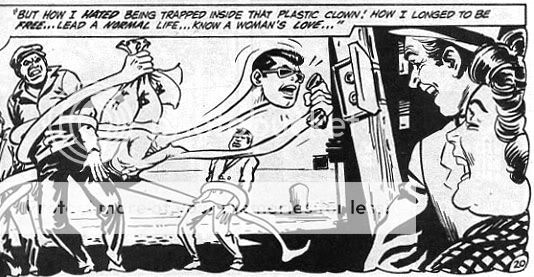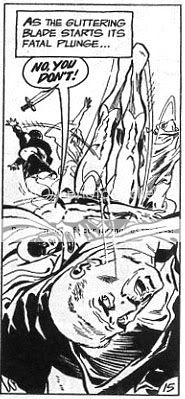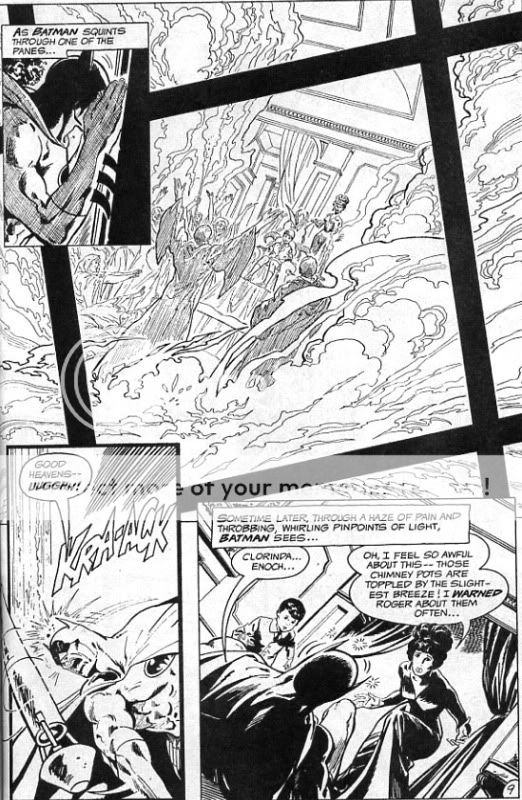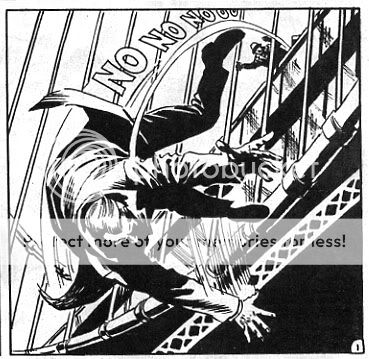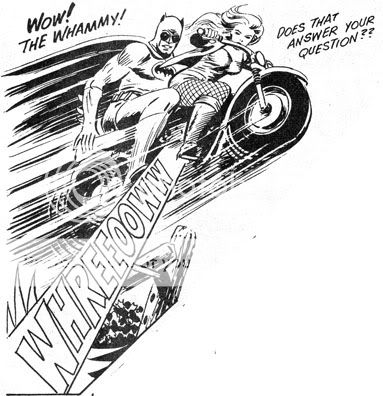For those of you coming in late, Tucker Stone and I are cross-blogging our way through a massive selection of classic Batman team-ups. Tucker does #88-#90, I do #91-#93, Tucker did #94-#96, and that brings you up to Bat-date.
But first let me bat-back-track a bat-bit (sorry…it’s kind of addictive, the bat-thing. But I will bat-stop bat-now.)
Bat-Ahem.
What I’m trying to say is that Tucker underplayed some of the truly bizarre pleasures offered by the Plastic-Man team-up in Brave and Bold #95. For instance, Tucker fails to mention that Batman, before being sprayed with “Tiger-Lover cologne”, sings, “Mairzy dotes and dozey dotes and the blazes with Ruby Ryder,” and then visibly checks out the mini-skirted ass of a passing young thing.
As if that weren’t justification enough for the entire issue, I have to say that I just loved the fact that Nick Cardy seemed to die a little death every time he was forced to draw Plastic-Man stretching.
You can just see Cardy looking at some old Jack Cole comics for reference and positively rending his garments as he whipsaws back and forth, pen in hand. “But…I’m a noir artist! I’m not drawing this cartoony crap! Bob! Bob! You can’t make me…eeeeeeeeyeeeaaaarggggh!”
That last was the sound of Woozy Winks coming out of Cardy’s ribcage, belching foetid boogers, greasepaint, and ketchup. Even Haney staggered back in horror…and as Winks scuttled up into the ventilation shaft , Bob knelt, tears streaming down his face, and promised his brave, brave friend — “It’s okay, Nick. It’s okay. I’ll make Plastic Man tragically conflicted, betrayed by an evil dame! It’ll be noir! It’ll work! You’ll see!”
And Cardy half sat up, eyes glistening, and said, slowly, feelingly, his voice faltering and racked with pain:
“Fuck you, Bob.”
And the rest was silence.
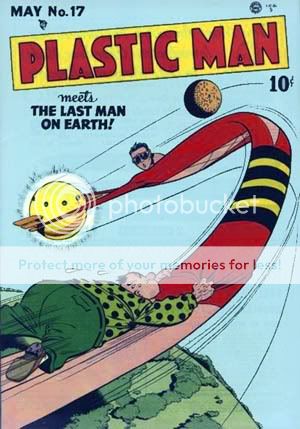
Woozy Winks: Plastic Man’s Pal or Alien Parasite?
The Brave & The Bold # 97
Written by Bob “Bob” Haney
Pencils by Bob “I’m Bob Too” Brown
Inks and cover by Nick “Not Bob” Cardy
Published by NAFTA, 1971
Oh, wait, one more thing before we start…if you read Tucker’s last post, you’ll find that he went and read an extensive interview with Haney, and is cherry-picking quotes to show us all that he’s done research and is a real professional comics critic. Faced with such diligence on the part of their interlocutors, some critics might feel a little belittled. Some critics might say, “well, I’m going to try to keep up by, say, googling Nick Cardy and finding out who the hell he is.” Or they might even say, “ha! I will find and read that Bob Haney interview too, and cherry-pick some quotes of my own, nyaaah.” Some critics maybe. But I am not that some critic, by God! You hear that, Tucker Stone! You hear that you fancy-striped-pants elitist?! Your intellectyual wiles aren’t going to work on me. I’ve got a brand to protect here! When people think “Noah Berlatsky” they think “Blogger too lazy to do even elementary fact-checking!” And I’m not going to ruin the brand just because some snot-nosed punk has a complete collection of Comics Journals hidden under his bed!
Right. Enough ranting. Let’s get down to business. Start off with a gag-cartoon-Nick -Cardy cover which is pure slapstick and has absolutely nothing to do with the story. Once again, our boy Nick is clearly resentful of the whole situation; so what if he has to draw a totally stale joke which would only make sense if you had big-feet funny animals running around? He’s still going to give it the full moody pulp treatment, with lots of expressive scribbled shadows. Why the hell not? (Actually, that cover doesn’t really look as good with the coloring. Can’t see the nifty scribbles in the shadows. But, hey, I figured out where all these covers live online. Take that, Tucker!)
Anyway, in the issue itself Cardy (recovering from his chest wound) passed the penciling chores off to Bob Brown, who lives up to his generic moniker by plopping down some thoroughly pedestrian Bat-art. It’s not embarrassing or anything. It’s just like…you know, when I was a kid, right around the time I first started reading the Brave and Bold, actually, I was really unclear on how art worked. I couldn’t draw myself, and it seemed to me impossible that anyone actually just sat down and drew all these pictures. So I imagined that there was, somewhere, a huge number of super-hero stamps, capturing every possible stance or position, and that when they needed a particular pose, they just found the stamp and thumped it down on the page in the proper place. (But then, of course, who drew the stamps, I wondered?) Anyway, Bob Brown’s the kind of professional, adequate, impersonal artist who seems to be working from those stamps. (As opposed to, say, Ross Andru, whose Batman looks like he was die-cast by a toy company.)
In the writing, the main point of interest is that the story is set in Mexico where everybody speaks English. The only English word they don’t seem to know is “man,” which is why they all call our hero “Bat-Hombre.” A similar thing happened in the issue set in England, you’ll remember, where the natives called him “Bat-Chap.” I’m looking forward to Australia (“Bat-Mate”); Japan (“Bat-Otaku,”) Communist Russia (“Bat-Imperialist-Pig-Dog”) and sunken R’leyah (“Bat-F’htagn”).
So in this issue Haney brings back Wildcat, who just teamed up with Bat-Whats-his-name like nine issues ago. I guess DC second-stringers were scarcer on the ground then.
(And how did they choose who co-starred, anyway? Were there polls? When I started picking up issues — around 130 or so, I think — I remember people writing in to ask for their favorite characters. Which is especially funny because the more you read these things, the more you realize the extent to which the guest-stars are beside the point; the goal often seems to be to give them as little face time as possible. And, of course, they’re personalities and even their powers are often virtually unrecognizable. Plastic-Man as whiny, tormented, love-sick, vengeful soul is a particularly egregious case of fan-scruff, but I don’t think the whiny, love-sick Black Canary is exactly canon either, nor the whiny, self-doubting Wildcat. At least he’s not love-sick…maybe because he’s got all those boy sidekicks?)
Anyway, this Wildcat might as well be a whole new character because, in typical Haney fashion, he spends the entire issue in an amnesiac fugue which renders him both speechless and useless. For all intents and purposes Batman is actually teamed up with some random Mexican boy diver named Luis. They’re searching for the treasure of Choclotan, which, it turns out, is a giant cache of Hershey Bars. Alas, the guy you think is going to double-cross everyone does, and a giant hulking baddy gets to box with Wildcat and bashes him in the head curing his amnesia. Then the recovered Wildcat duplicitously arranges for all the bad guys to die horribly by drowning, because, as Tucker points out, back then killing wasn’t exactly a super-hero’s business but still, business wasn’t bad.
Favorite quotes: “Now as knives flash in the limpid Mexican dusk, a brave boy stands at bay — and a man from far northern haunts comes face to face with the mystery, the mastery of the past, meeting an old ally, finding new foes, as fate flaunts the Batman with ….The Smile of Choclotan!”
“All of Mexico’s other gods were sourpusses, but legend says Choclotan, greatest god of all…alone wears a smile!”
Why does he wear a smile, you ask? Because he’s thinking about people drowning. That always cheers me up, too.
Extra fun fact: Judging from this issue, it appears that no women live in Mexico.
The Brave & The Bold # 98
Written by Bob “Haunted” Haney
Art by Jim “Apparition” Aparo
Cover by Nick “Casper” Cardy
Published by Roman Polanski, 1971
I tried to make the best of it, but I’ve got to admit that #97 was…well, maybe not the apogee of Batness. #98, though, is the bat-shit, the whole bat-shit, and nothing but the bat-shit.
As I said, I love the way Cardy and Haney work at cross-purposes. You can see it on this cover, too, where Cardy goes balls-to-the-wall-pulp; a curvaceous lovely in a slit skirt, monstrous silhouette, ugly demonic caricatures, amorphous ghostly figure, Batman laid out on a slab. It’s awesome…and then you realize the evil lady is declaring, “Now come forth…and kill the godfather!” And you dissolve into giggles.
Jim Aparo, though, is a whole different thing. Where Cardy tries to ground Haney’s drug-addled scripts with solid, working-class pulp and action tropes, Aparo just grins and says, “Pass the bong”. The result is an effervescently escalating edifice of tomfoolery. Haney churns out one of his most gloriously doddering efforts, with witches’ covens, evil twin doubles, wicked townsfolk, voodoo, hexes, a guest appearance by Lucifer, and the Phantom Stranger beating the tar out of Batman every other panel, supposedly for the Bat-guys own good (suuuuure.) Also, Batman, the Stranger and a psychiatrist commit what the psychiatrist refers to as “technically” child abduction — they throw a seven-year-old in a sack, steal him from his house, and then lock him in a room with a bunch of scary-looking occult objects. For, like, several. days. Because they think he’s a warlock. But he isn’t. So he’s traumatized for life, and when he grows up he’s probably going to draw gratuitously vertiginous panels like this one:
Or this:
Can I say how much I love that? Just as Haney is willing to chuck sense and coherence out the window the minute he lights on the next shiny bit of alliteration, so Aparo will cheerily defenestrate visual coherence for the chance to draw the ensuing oddly contorted wreckage. And, by the same token, where Cardy seemed a little hesitant about all the wacky super-hero special effects, Aparo just lives for it. Check this out:
Or how about this?
Total beautiful mystical wackiness. And then, after that glorious money shot, does Batman leap in and heroically save the day? Uh-uh; he just gets decked by a chimney pot.
Stuff like that is always happening to Haney’s Batman; he’s constantly walking into traps, or being forced to clean up Gotham by a bunch of adolescents, or discovering that his oldest friend married a witch, or that his godchild is demonspawn, or getting kicked around by the Phantom Stranger. I mean, he’s obviously ripped, and he swings around on a rope and stuff but overall, he seems pretty…well, not very super-heroic. He’s just some guy who wears a funny suit…which, yeah, is kind of a faux pas, but people let him get away with it because, you know, he’s clearly just trying to help.
What I’m saying here is that the whole driven, super-ninja, ultra-competent Batman…it’s pretty recent, I think. It’s probably Frank Miller’s fault, or maybe Denny O’Neill’s. Bob Haney’s Batman is, if anything, smaller-than-life. He’s not mysterious at all; in theory he’s got a double-identity going, but in practice he acts as if he’s got his own Bat-Social Security Card and a bat-driver’s license with his cowl on it (maybe he does; I wouldn’t put it past Haney.) He gives a member of the coven his autograph (again,the whole Greatest Detective thing is just not happening) and she uses it to hex him. And the hex works, because even Satan didn’t bother to think for a second: “Hey…wait a minute…Batman isn’t his real name.”
Oddly the extent to which Haney obviously doesn’t give two bat-farts about the dual identity thing is even clearer when Bruce Wayne ostensibly plays a bigger role. In the next issue, #99, the plot starts off at the Wayne summer home…but Batman goes dressed in his costume! There’s some reference made to Wayne leasing the home to Batman…but for God’s sake, why? Just go to your summer home in your civvies, man! It’s your house!
But if you did that, of course, you’d have to spend almost the entire issue drawing pictures of Bruce Wayne, not Batman, which is, presumably, not what the kiddies are paying for. (Though it’s fine for the guest stars…Flash spends most of the comic dressed as Barry Allen.)
Hey, we’ve started to talk about the next issue, it looks like. Let’s throw one of these on the fire then…
The Brave & The Bold # 99
Written by Bob “the Slob” Haney
Art by Bob “the Blob” Brown
Cover by Neal “the Real” Adams and Dick “the Slick” Giordano
Published by Wayne Enterprises, 1971
Back to Bob Brown, alas. It’s a shame too, because Jim Aparo would have had a blast with this one. (Nice cover, though. Neal Adam’s stuff actually looks better in color, I think, whereas Cardy’s loses something. Maybe another reason the first is a household name (if you’re in a nerd household, anyway) and the second not quite so much.)
In the comments to my last post, my brother Eric made a crack suggesting that Haney doesn’t have that many ideas. Not to start something with my own flesh and blood, but this story demonstrates why that claim is completely bass ackwards. The truth is that Haney’s got ideas coming out of his gazebo. When he scratches his head, ideas come flaking off like dandruff. They’re not all original or good of course — but if you’ve got enough of them, that starts to matter less than you might think.
The plot here for instance. On the one hand, you’ve got a storyline about Bruce Wayne (always in costume) discovering that his father was a mad scientist who had figured out how to come back from the dead — so Bruce decides to finish the experiments and bring his parents back. Then, on the other hand, you’ve got a storyline about Batman being possessed by an evil pirate who wants to bring back all the spirits from limbo to possess the living and take over the world.
Obviously, these plots overlap. But the point is that either one by itself is sufficient for a solid pulp comic-book plot. Either one, by itself, would make sense (in the way comic-book plots usually make sense, anyway.)
But Haney is too enamored of his ideas to let any of them go; he shoehorns both storylines into one story, and lets them fight it out. And pretty soon, instead of a nice, clean story with a beginning, middle, and end, you’ve got severed bits of plot lying strewn across the panels, twitching and occasionally rising to struggle hideously onto the next page. Batman experiences not one, but two bizarre personality transformations. First, he becomes obsessed with resurrecting his parents, heedless of the consequences — basically, he forgets he’s a super-hero and starts acting like the protagonist in a Lovecraft story (Bat-F’htagn!) But, at the same time, he’s suffering bouts of possession, where he’s taken over by the spirit of dead Manuel, the Port-a-gee. (Yes, that’s how everyone spells it.)
In other words, what should, in some world, be a classic gothic story, dripping with repression, displacement, and the anxiety of doubling, instead fractures. Confusion of identity plays out not as tragedy or horror, but as self-parodic farce. There are lots of references to bifurcated identity, but they all tend to add up to pratfalls. In the very first line of the story, Batman says he’s rushed to his summer house so quickly that “he didn’t even change the old Bat-Suit!” The probable presence of BO becomes even stronger shortly thereafter, when Barry Allen explains that Batman has to wear his suit all the time, even when he sleeps. Why? Because when he’s possessed, Batman has a distinctive walk — the pirate, you see, had a wooden leg, which he apparently retains even in death. So Bruce Wayne must continue to wear his smelly mask lest everyone discover that it is he, not Batman, possessed by the improbably limping ghost.When Barry Allen earnestly worries, “Poor guy — under that tough, super-hero hide is a sensitive, lonely man!” you’ve got to wonder…is the costume tough from grime? And why’s Batman so lonely, anyway? There are like three people in there, depending on whether you count that wooden leg separately. The perfect coup-de-gras is when Batman discovers that the urn with his parents ashes contains only sand — but don’t worry! Flash finds an exactly identical urn with the real ashes instantly. And then he sends Batman off the island, promising the authorities the Caped Crusader will get psychiatric help — which is a lie because we all know Batman wasn’t really nuts, he was just possessed…except that he was really nuts…but presumably both he and the Flash forgot that, since it happened on the last page. It’s too bad; I’d have liked to see Batman, in full costume, lying on a couch and getting the talking cure.
The multiple-multiple-personality Batman is emblematic of the way Haney writes everybody; characterization for him seems to be a function…not of the plot, exactly, but just of whatever fleeting idea he gets in his head while he’s working on any particular speech bubble.
The funny thing is, this is maybe the single “truest” version of Batman…or of any of his guest stars. People like to say, “Oh, Batman should be dark and dangerous” or “Superman should be noble,” or “Green Lantern should be Hal Jordan.” Whatever. They’re all corporate-owned properties; they’ve been passed around, fondled, and abused by so many different manipulators and users that they’re all pretty much just gibbering, drooling slabs of meat by this point. They don’t have souls; they don’t have identities. They’re just zombie bricks for the bricolage, and Bob Haney’s the zombie king.
Update: Edited for various embarrassing name mix-ups.
Update 2: Tucker does part five here


